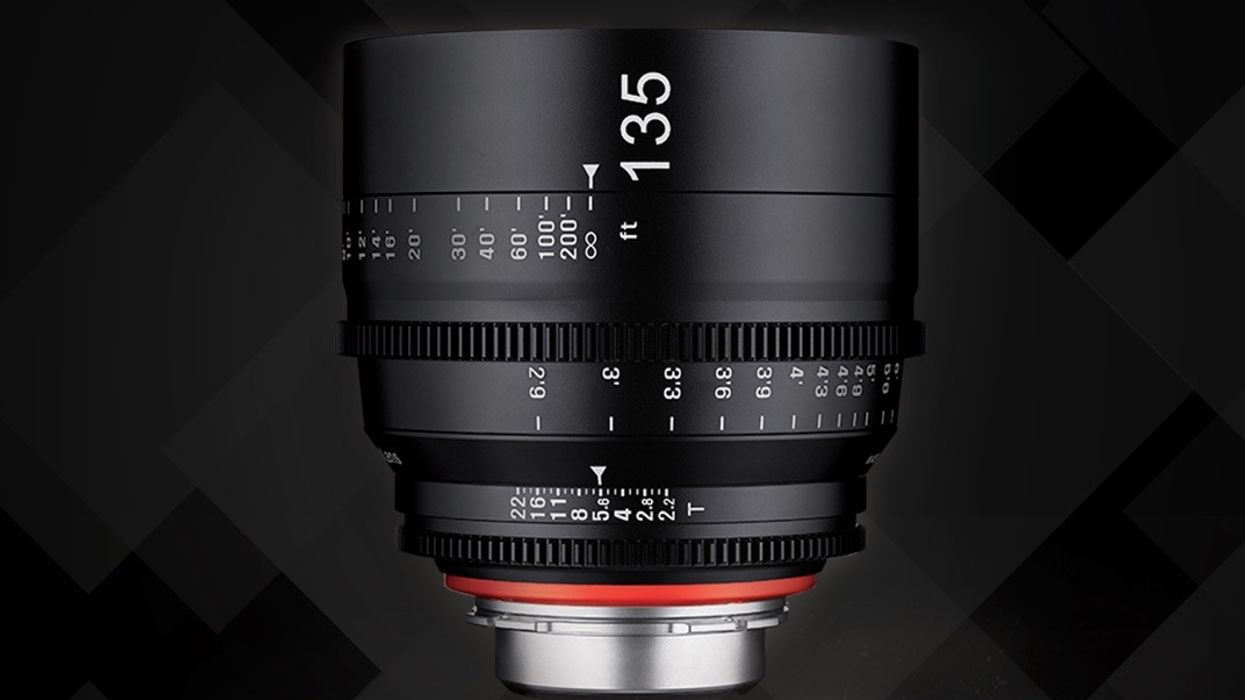Samyang Kicks Off 'Summer Blockbuster' Lenses with XEEN 135mm Prime
Samyang has chosen a cinema lens as the opening salvo in a series of five lenses that will be released weekly throughout the summer.

Today's announcement of the 135mm XEEN T2.2 prime lens from Samyang kicks off their “Summer Blockbuster” series of lens announcements, as the South Korean manufacturer works to further fill out its XEEN line of cinema-oriented, cost-effective lenses after some great additions earlier this year.
With an initial price point of $2,495 (and with previous lenses in the series occasionally available in the $2,200 range), this is the most affordable new lens with a warranty available in PL mount, coming in at around half the CP.2 line from Germany’s Zeiss.
One of the beauties of lens ownership is that lens quality changes less drastically over time than camera sensor quality. You still see lens sets from the '80s in regular rotation (the original Zeiss Super Speeds and Standard Speeds come to mind), and when going for a specific vintage look, you’ll often see the beloved-by-Gordon-Willis Cooke Speed Panchros in the wild. Compare this to imagers, where it’s becoming rare to even see the RED-MX out in the field; the hottest camera of 2006—the HVX-200—is also rarely seen.

The technology that makes this possible is, of course, the PL mount. Introduced by Arri in 1982, and widely adapted by pretty much every cinema camera platform except Panavision (which has stuck by its PV mount), the PL mount makes it pretty easy to use '80s glass on a modern camera. It’s a standard that works.
In the digital cinema era, we aren’t always so lucky. There are a ton of lens mounts fighting for dominance, and attempts to create common sense standards (like micro 4/3) that transcend brand only end up clouding the field.
The lenses are designed for interchangeable mounts.
This is one of the features that makes the XEEN line from Samyang—which also makes the Rokinon lenses many DSLR shooters love—so fantastic: the lenses are designed for interchangeable mounts. This means that you can invest in lenses now, mounted for your personal Sony E-mount camera (A7S, for instance), but if you book a feature shooting the Alexa, you can re-mount your glass for PL and shoot on the same lenses you know inside and out instead of having to rent unfamiliar PL mount glass.
This is similar to what many cinematographers have long practiced in the PL world, owning a set of beloved lenses that work on projects shot on Arri, Aaton, Moviecam, RED, Phantom or Dalsa. Familiarity with a set of glass—how it flares, how it focuses, how each lens renders a face—is a valuable thing, and interchangeable mounts on the glass should hopefully be something we see more of in the future.

While the marketing (especially on the XEEN site itself) is somewhat confusing on this point, the lens mount isn’t field-changeable: you need to take it to a qualified lens service technician for a mount swap. This is understandable—you want a very precise mounting to ensure proper focusing on the image plane—but, of course, it would be great if there were a system for this to be done by an end-user.
While I would never actively put myself in a situation where I had a PL mount A-camera and an E-mount B-camera and wanted to share the same pool of lenses, requiring constant switches, I can certainly imagine plenty of on-set situations where you might find yourself needing to make the switch in the field.
The combination of closer focus with longer focal length should make for an excellent portrait/close-up lens.
Today's 135mm significantly increases the telephoto end of the spectrum for the series, though it isn’t able to maintain the T1.5 maximum aperture seen in Samyang's 24, 35, 50, and 85mm glass. This is somewhat to be expected; as lenses get longer, they require physically wider glass to reach the same maximum aperture (F-stop is the relationship of lens length to width, after all), and with this platform, uniformity of ergonomics between the lenses and consistency of pricing is simply more important. This lens maintains the 114mm front diameter and focus and aperture ring placement, speeding up lens swaps on set.
It also has a claimed close-focus of .8 meters/2.6 feet, closer than the 85mm, with its close focus of 1.2 meters/3.7 feet. The combination of closer focus with longer focal length should make for an excellent portrait/close-up lens, though we aren’t quite into macro territory. With these specs, I’d be as likely to take out the 135mm as the 85mm if I weren't able to rent or buy the full set.

Up next, Samyang is teasing something in between the 14mm and the 24mm. Since the 14mm has a maximum aperture of T3.1—around two stops slower than the main line of lenses—it seems likely we’ll see something wider than 24mm, but in keeping with the T1.5 standard. Rokinon already has a 16mm T2.2 cine lens, only one stop from the main T1.5 aperture line, that Samyang could use as a basis for a new XEEN. But that lens only covers Super 35mm, not Full Frame, and would require re-engineering to fit in with the rest of the platform.
There were some reports of a noticeable color shift from T4 to T5.6 with earlier releases of the XEEN line and a slightly odd shape to the full-aperture bokeh, but otherwise initial reports appear to be very positive.
Tech specs:
- 114mm Front Diameter
- Aluminum Housing
- Consistent Focus/Aperture ring placement
- Internal Focus (non-rotating front element)
- Covers Full Frame 35mm/8K VistaVision (RED)
- Mounts: PL, Canon EF, Nikon F, Sony E, Micro 4/3
- Available in Metric or Imperial Measurement
- 200° focus rotation
- 11 Blade Iris
- 1/4”-20 threaded hole for lens support
- 3-year limited warranty (voided if self-service lens mount change)
Has any of you put these lenses through the paces yet? What did you think? Let us know in the comments.












